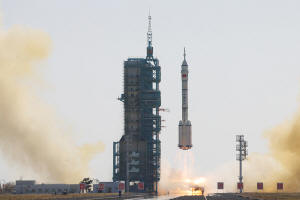China's youngest-ever crew of astronauts heads to space station
 Send a link to a friend
Send a link to a friend
 [October 26, 2023]
By Ryan Woo [October 26, 2023]
By Ryan Woo
BEIJING (Reuters) -The youngest-ever crew of Chinese astronauts departed
for China's space station on Thursday, paving the way for a new
generation of "taikonauts" to advance the country's space ambitions in
the future.
The spacecraft Shenzhou-17, or "Divine Vessel", and its three passengers
lifted off atop a Long March-2F rocket from the Jiuquan Satellite Launch
Centre in northwest China.
Leading the six-month mission was former air force pilot Tang Hongbo,
48, who was on the first crewed mission to the space station in 2021.
His return to the orbiting outpost Tiangong, or "Celestial Palace" in
Chinese, also set a new record for the shortest interval between two
spaceflight missions by taikonauts - coined from the Chinese word for
space - suggesting a faster rotation of taikonauts in coming years.
Tang, from China's second batch of astronauts in 2010, had to wait more
than a decade before he was picked for his inaugural spaceflight in
2021.
By contrast, his fellow Shenzhou-17 crew members Tang Shengjie, 33, and
Jiang Xinlin, 35, both travelling to space for the first time, joined
China's third batch of astronauts in September 2020.

China has already kickstarted the selection process for the fourth batch
of astronauts, seeking candidates with doctoral degrees in disciplines
from biology, physics and chemistry to biomedical engineering and
astronomy.
It is also opening the process to applicants from Hong Kong and Macau
for the first time.
The first and second batches of astronauts were all former air force
pilots, like Tang, who joined the People's Liberation Army in 1995 at
age 20.
FOREIGN ASTRONAUTS
The selection and training process will commence soon for foreign
astronauts looking to participate in joint flights to Tiangong, a senior
official on China's manned space program said this year.
[to top of second column]
|

A Long March-2F carrier rocket, carrying the Shenzhou-17 spacecraft,
takes off from Jiuquan Satellite Launch Center for a crewed mission
to China's Tiangong space station, near Jiuquan, Gansu province,
China October 26, 2023. China Daily via REUTERS

But as much as China is showcasing its efforts to internationalise
its space missions, its space program has distinct Chinese
characteristics, at least on Tiangong.
In a departure from the NASA-led International Space Station (ISS),
where English is the working language, only Chinese is used on
Tiangong, making Chinese-language skills a key criteria for foreign
participants.
Tiangong has become a symbol of China's growing confidence in its
space endeavours after being shut out of the ISS program for
decades. China is banned by U.S. law from any collaboration, direct
or indirect, with NASA.
Tiangong, completed in late 2022, can house a maximum of three
astronauts at an orbital altitude of up to 450 km (280 miles) and
will have an operational lifespan of more than 15 years.
The Shenzhou-17 astronauts will replace the Shenzhou-16 crew, who
arrived at Tiangong at the end of May.
The Shenzhou-16 crew, consisting of veteran astronaut Jing Haipeng,
Zhu Yangzhu and Gui Haichao, is scheduled to return to earth on Oct.
31.
Zhu and Gui, both in their 30s, are from China's third batch of
astronauts.
Shenzhou-17 marks China's 12th crewed mission since Yang Liwei's
solo spaceflight in October 2003, the first Chinese national in
space.
(Reporting by Ryan Woo; Editing by Tom Hogue and Gerry Doyle)
[© 2023 Thomson Reuters. All rights
reserved.]This material
may not be published, broadcast, rewritten or redistributed.
Thompson Reuters is solely responsible for this content.
 |